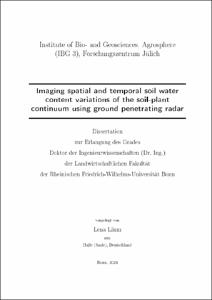Imaging spatial and temporal soil water content variations of the soil-plant continuum using ground penetrating radar

Imaging spatial and temporal soil water content variations of the soil-plant continuum using ground penetrating radar

| dc.contributor.advisor | Schnepf, Andrea | |
| dc.contributor.author | Lärm, Lena | |
| dc.date.accessioned | 2024-07-23T07:20:56Z | |
| dc.date.available | 2025-09-01T22:00:13Z | |
| dc.date.issued | 23.07.2024 | |
| dc.identifier.uri | https://hdl.handle.net/20.500.11811/11706 | |
| dc.description.abstract | The soil-plant continuum regulates a wide range of processes, which are crucial for plant performance, such as root water and nutrient uptake and the spatio-temporal distribution of soil water. Especially for agricultural crops within agro-ecosystems detailed understanding of processes and interactions is essential, since agriculture is majorly impacted by climate change and holds the potential to meet the requirements of increasing feed and food demand. The non-invasive imaging of processes and the estimation of important parameters and state variables concerning the soil-plant continuum, in particular root system architecture, soil water content (SWC) distribution and soil hydraulic properties can help to optimize agricultural management practices and enhance yield productivity while minimizing the use of natural resources. Currently, most of the processes and parameters are are being separately investigated, at different scales, by differing research fields such as agrogeophysics and crop science. Since the different components influence each other a separate consideration is not feasible and more combined research is needed. One approach is to join agrogeopyshical methods such as ground penetrating radar (GPR) and root information to monitor and characterize the soil-plant continuum. In this study an open-source data set including soil sensor data, root images and GPR permittivities from five years for various crops types and agricultural treatments was established. For all of these data new standards were created and provide a novel comprehensive data set for other researchers. Within this time-lapse data set, certain effects on the GPR signal related to soil type, surface water treatment, atmospheric conditions and previous soil management could be identified. Therefore, the impact of row crops, such as maize, on the horizontal spatio-temporal distribution on the permittivity and hence SWC was investigated. A statistical analysis method for the visualization was developed, by deriving the so-called trend-corrected spatial permittivity deviations of the vegetated field. Thereby, a link and correlation between the permittivity variability and the root volume fractions was observed. For the further quantification of the relation between the recorded GPR signals and the presence of roots and above-ground shoot, a numerical study was performed. Under the consideration of different scenarios. Roots showed a greater impact than the above-ground shoot and additionally standard analysis tools, such as first arrival picking could be confirmed for investigating the soil-plant continuum using crosshole GPR applications. Additionally, a new approach to derive the actual available water in the soil was presented, showing that neglecting the root phase in appropriate petrophysical mixing models overestimated the SWC. For the further investigation of the plant available water, we considered the horizontal crosshole GPR-derived SWCs for a winter wheat growing season in combination with a hydrological model to derive the soil hydraulic parameters. In a first step this sequential hydrogeophysical inversion was used for a one-dimensional averaged case and was upscaled in a second step to the plot scale, where the pseudo three-dimensional spatially distributed soil hydraulic parameters for the dual-porosity Mualem-van-Genuchten model were estimated. Considering these different aspects of soil-plant interaction of hydrological and biological processes improved the understanding of GPR signal within the soil-plant continuum and how information can be derived and applied to non-invasively monitor and characterize cropped fields. Nevertheless, to fully facilitate GPR as tool in sustainable agriculture, further work could focus on the use of surface GPR applications, correlation with spatially distributed root information, combining electromagnetic and root architecture models and combining GPR with investigation methods at the pedon- to regional scale. | en |
| dc.language.iso | eng | |
| dc.rights | In Copyright | |
| dc.rights.uri | http://rightsstatements.org/vocab/InC/1.0/ | |
| dc.subject.ddc | 550 Geowissenschaften | |
| dc.title | Imaging spatial and temporal soil water content variations of the soil-plant continuum using ground penetrating radar | |
| dc.type | Dissertation oder Habilitation | |
| dc.publisher.name | Universitäts- und Landesbibliothek Bonn | |
| dc.publisher.location | Bonn | |
| dc.rights.accessRights | openAccess | |
| dc.identifier.urn | https://nbn-resolving.org/urn:nbn:de:hbz:5-77083 | |
| dc.relation.doi | https://doi.org/10.2136/vzj2019.05.0044 | |
| dc.relation.doi | https://doi.org/10.34133/2022/9758532 | |
| dc.relation.doi | https://doi.org/10.1016/j.jhydrol.2021.126010 | |
| ulbbn.pubtype | Erstveröffentlichung | |
| ulbbnediss.affiliation.name | Rheinische Friedrich-Wilhelms-Universität Bonn | |
| ulbbnediss.affiliation.location | Bonn | |
| ulbbnediss.thesis.level | Dissertation | |
| ulbbnediss.dissID | 7708 | |
| ulbbnediss.date.accepted | 08.04.2024 | |
| ulbbnediss.institute | Angegliederte Institute, verbundene wissenschaftliche Einrichtungen : Bonner Akademie für Forschung und Lehre praktischer Politik (BAPP) | |
| ulbbnediss.fakultaet | Landwirtschaftliche Fakultät | |
| dc.contributor.coReferee | Klotzsche, Anja | |
| ulbbnediss.contributor.orcid | https://orcid.org/0000-0002-0633-4293 | |
| ulbbnediss.date.embargoEndDate | 01.09.2025 | |
| ulbbnediss.contributor.gnd | 1360481834 |
Dateien zu dieser Ressource
Das Dokument erscheint in:
-
E-Dissertationen (1128)




